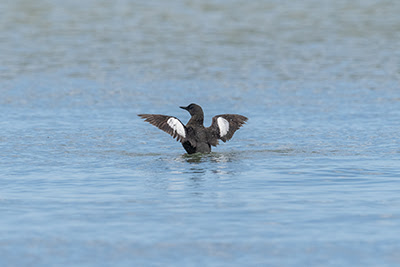Killdeer have become remarkably rare in recent years. Back in 2007 when Malc, Al and Jason were all year listing, a Killdeer turned up on Shetland and was apparently paired up with a Ringed Plover. People thought we were mad to travel all that way just for a Killdeer but there hasn't really been a twitchable one since in the UK and wit ha supporting cast of Melodious Warbler, Blyths Reed Warbler, Common Rosefinch and a spring male Red-breasted Flycatcher plans were made to drive to Aberdeen and fly to Sumburgh to spend a few days mopping up a few good species in early June.
This was to be my first visit to Shetland since July 1976 when I went up with friends as a 15 year old birder specifically to see Albert the Black-browed Albatross at Hermaness but also Fetlars resident Snowy Owls and Red-necked Phalaropes.
The flight from Aberdeen was foggy but the pilot hoped it would clear before we reached Sumburgh. Unfortunately it didn't and, despite two passes with the landing gear down, we ended up back in Aberdeen and having to make a mad dash in a taxi across Aberdeen to the Northlink ferry terminal where we spent an uncomfortable night trying to sleep in the restaurant. Luckily we'd managed to contact Bolts car hire who met us from the ferry rather than Sumburgh airport. Unluckily it had been a clear night and a lot of birds had moved on.
The Killdeer had been seen around a muddy pool north of th Pool of Virkie so we headed there first. Despite searching we couldn't find it although I was convinced I'd heard it. With Common Rosefinch being reported as being still at Sumburgh Hotel I elected to stay whilst the others took the hire car and went to salvage a year tick.
I continued searching the area pausing only to try and photograph a Shetland Wren. Distracted I didn't hear the distinctive sound of a Bonxies wings as a pair attacked me in full aggressive flight mode and the next thing I knew I was flat on my back with blood dripping into my left eye and trying to fend an angry Bonxie off with my camera. Eventually, honour satisfied, the pair went back to survey their handiwork from a nearby mound whilst I beat a hasty retreat.
Working my way back to the muddy pool on top of the cliffs I once again thought I heard the Killdeer and sure enough the bird flew in and landed just in front of me and promptly went into its distinctive broken wing distraction display. Quickly phoning the others I stayed a respectful distance until they arrived. In the meantime another birder had arrived and proceeded to get ever closer to the Killdeer until I warned him he was liable to get pushed headfirst into the pond by some angry mancs if her persisted. Luckily he was sensible about it and stood watching from a distance alongside me.
Satisfied we headed back to our hotel in Lerwick detouring on the way for a Red-breasted Flycathcer that had been reported from Geosetter.
This is still the only Killdeer I've seen in the UK after an abortive trip to Alston, Lancs in 2013 for the bird that only stayed a few hours
That spring trip was the start of my love for Shetland birding and we went back again in the autumn where we caught up with a Melodious Warbler, for the lads year list, on Unst and a lifer in the form of Swainsons Thrush on Fetlar - my first trip to Fetlar since 1976. We also caught up with Red-backed Shrike on Fetlar and a Sardinian Warbler at Spiggie.
 |
| Melodious Warbler, Sept 2007, Baltasound, Unst |
 |
| Swainsons Thrush, Houbie, Fetlar with Al & Malc in the background! |








































































































